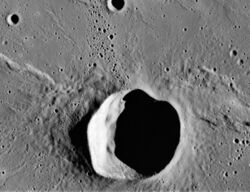Astronomy:Herigonius (crater)
 Apollo 16 Mapping camera image | |
| Diameter | 15 km |
|---|---|
| Depth | 2.1 km |
| Colongitude | 34° at sunrise |
Herigonius is a small lunar impact crater that is located in the southern part of the Oceanus Procellarum, to the northeast of the crater Gassendi. It was named after French mathematician and astronomer Pierre Hérigone.[1] Herigonius is roughly circular, with an inward bulge and narrower inner wall along the northeast. In the interior of the sloping inner walls is a floor about half the diameter of the crater.
About 60 kilometers to the west of Herigonius is a sinuous rille designated Rimae Herigonius. This cleft is about 100 kilometers in length and runs generally in a north–south direction, while curving to the east at the north end.
Two mountains within a highland mass informally called "The Helmet" (by the Apollo 16 crew) are informally named Herigonius Eta (η) and Herigonius Pi (π). Eta is the larger mountain on the northern edge of the Helmet, and Pi is along the southwest edge. North and northwest of the crater is the wrinkle ridge Dorsa Ewing, which also contacts Rimae Herigonius.
Satellite craters
By convention these features are identified on lunar maps by placing the letter on the side of the crater midpoint that is closest to Herigonius.
| Herigonius | Latitude | Longitude | Diameter |
|---|---|---|---|
| E | 13.8° S | 35.6° W | 7 km |
| F | 15.5° S | 35.0° W | 5 km |
| G | 15.3° S | 32.4° W | 3 km |
| H | 17.0° S | 33.2° W | 4 km |
| K | 12.8° S | 36.4° W | 3 km |
References
- ↑ "Herigonius (crater)". Gazetteer of Planetary Nomenclature. USGS Astrogeology Research Program.
- Andersson, L. E.; Whitaker, E. A. (1982). NASA Catalogue of Lunar Nomenclature. NASA RP-1097.
- Bussey, B.; Spudis, P. (2004). The Clementine Atlas of the Moon. New York: Cambridge University Press. ISBN 978-0-521-81528-4.
- Cocks, Elijah E.; Cocks, Josiah C. (1995). Who's Who on the Moon: A Biographical Dictionary of Lunar Nomenclature. Tudor Publishers. ISBN 978-0-936389-27-1. https://archive.org/details/isbn_9780936389271.
- McDowell, Jonathan (July 15, 2007). "Lunar Nomenclature". Jonathan's Space Report. http://host.planet4589.org/astro/lunar/.
- Menzel, D. H.; Minnaert, M.; Levin, B.; Dollfus, A.; Bell, B. (1971). "Report on Lunar Nomenclature by the Working Group of Commission 17 of the IAU". Space Science Reviews 12 (2): 136–186. doi:10.1007/BF00171763. Bibcode: 1971SSRv...12..136M.
- Moore, Patrick (2001). On the Moon. Sterling Publishing Co.. ISBN 978-0-304-35469-6. https://archive.org/details/patrickmooreonmo00patr.
- Price, Fred W. (1988). The Moon Observer's Handbook. Cambridge University Press. ISBN 978-0-521-33500-3.
- Rükl, Antonín (1990). Atlas of the Moon. Kalmbach Books. ISBN 978-0-913135-17-4.
- Webb, Rev. T. W. (1962). Celestial Objects for Common Telescopes (6th revised ed.). Dover. ISBN 978-0-486-20917-3. https://archive.org/details/celestialobjects00webb.
- Whitaker, Ewen A. (1999). Mapping and Naming the Moon. Cambridge University Press. ISBN 978-0-521-62248-6.
- Wlasuk, Peter T. (2000). Observing the Moon. Springer. ISBN 978-1-85233-193-1.
External links
- Herigonius K Impact Melt Flow - Lunar Reconnaissance Orbiter page with images
 |





